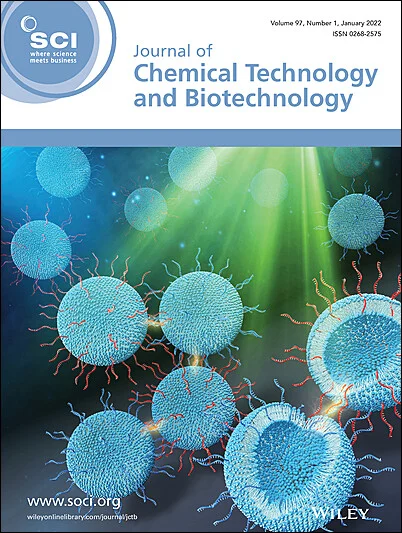Darya A Konovalova, Anton P Koskin, Sergey A Stepanenko, Roman G Kukushkin, Daniil I Lashchenko, Petr M Yeletsky, Vadim A Yakovlev
求助PDF
{"title":"Lignocellulosic biomass conversion into ethylene glycol using heterogeneous catalysts: a mini-review","authors":"Darya A Konovalova, Anton P Koskin, Sergey A Stepanenko, Roman G Kukushkin, Daniil I Lashchenko, Petr M Yeletsky, Vadim A Yakovlev","doi":"10.1002/jctb.70052","DOIUrl":null,"url":null,"abstract":"<p>Ethylene glycol (EG) is known to be a large-tonnage industrial chemical produced mainly <i>via</i> energy-intensive processes from ethylene oxide generally obtained from petroleum feedstock. At the same time, lignocellulosic biomass represents a green and sustainable alternative to the fossil feedstocks for EG production. Beside the properly selected reaction conditions, the key point of success for this complex process is in the development of a suitable multifunctional catalyst ensuring necessary rates of the reactions. This mini-review article surveys recent achievements in the development of heterogeneous catalysts for the conversion of cellulose into green ethylene glycol – both extracted and in the composition of lignocellulose biomass. The literature review showed that utilization of W-based and Ni or Ru-based catalysts allows for achievement of promising ethylene glycol yields from lignocellulose biomass (~ 40–60 wt. %). However, using real biomass feedstocks remains quite challenging and requires additional research as now only more than dozen reports present in the literature. In addition to summarizing current progress, this article outlines future research directions aimed at developing robust, low-cost, and scalable catalytic systems suitable for practical application. By promoting biomass-derived EG production, this work contributes to the advancement of sustainable chemical manufacturing, energy security, and rural biomass valorization – offering potential socioeconomic benefits through reduced dependence on fossil resources, lowered carbon footprint, and enhanced regional circular bioeconomies. © 2025 Society of Chemical Industry (SCI).</p>","PeriodicalId":15335,"journal":{"name":"Journal of chemical technology and biotechnology","volume":"100 11","pages":"2251-2258"},"PeriodicalIF":2.4000,"publicationDate":"2025-08-26","publicationTypes":"Journal Article","fieldsOfStudy":null,"isOpenAccess":false,"openAccessPdf":"","citationCount":"0","resultStr":null,"platform":"Semanticscholar","paperid":null,"PeriodicalName":"Journal of chemical technology and biotechnology","FirstCategoryId":"5","ListUrlMain":"https://scijournals.onlinelibrary.wiley.com/doi/10.1002/jctb.70052","RegionNum":4,"RegionCategory":"生物学","ArticlePicture":[],"TitleCN":null,"AbstractTextCN":null,"PMCID":null,"EPubDate":"","PubModel":"","JCR":"Q3","JCRName":"BIOTECHNOLOGY & APPLIED MICROBIOLOGY","Score":null,"Total":0}
引用次数: 0
引用
批量引用
Abstract
Ethylene glycol (EG) is known to be a large-tonnage industrial chemical produced mainly via energy-intensive processes from ethylene oxide generally obtained from petroleum feedstock. At the same time, lignocellulosic biomass represents a green and sustainable alternative to the fossil feedstocks for EG production. Beside the properly selected reaction conditions, the key point of success for this complex process is in the development of a suitable multifunctional catalyst ensuring necessary rates of the reactions. This mini-review article surveys recent achievements in the development of heterogeneous catalysts for the conversion of cellulose into green ethylene glycol – both extracted and in the composition of lignocellulose biomass. The literature review showed that utilization of W-based and Ni or Ru-based catalysts allows for achievement of promising ethylene glycol yields from lignocellulose biomass (~ 40–60 wt. %). However, using real biomass feedstocks remains quite challenging and requires additional research as now only more than dozen reports present in the literature. In addition to summarizing current progress, this article outlines future research directions aimed at developing robust, low-cost, and scalable catalytic systems suitable for practical application. By promoting biomass-derived EG production, this work contributes to the advancement of sustainable chemical manufacturing, energy security, and rural biomass valorization – offering potential socioeconomic benefits through reduced dependence on fossil resources, lowered carbon footprint, and enhanced regional circular bioeconomies. © 2025 Society of Chemical Industry (SCI).
使用多相催化剂的木质纤维素生物质转化为乙二醇:一个小型综述
众所周知,乙二醇(EG)是一种大吨位的工业化学品,主要是通过能源密集型工艺从石油原料中获得的环氧乙烷中生产出来的。与此同时,木质纤维素生物质代表了一种绿色和可持续的替代品,可以替代化石原料生产EG。除了正确选择反应条件外,这个复杂过程成功的关键在于开发合适的多功能催化剂,确保必要的反应速率。本文综述了近年来纤维素转化为绿色乙二醇的多相催化剂的研究进展,包括提取和木质纤维素生物质的组成。文献综述表明,利用w基和Ni或ru基催化剂可以从木质纤维素生物质(~ 40-60 wt)中获得有希望的乙二醇产量。%)。然而,使用真正的生物质原料仍然相当具有挑战性,需要额外的研究,目前文献中只有十几篇报道。除了总结目前的进展外,本文还概述了未来的研究方向,旨在开发适合实际应用的稳定,低成本和可扩展的催化系统。通过促进生物质衍生EG生产,本工作有助于推进可持续化工制造、能源安全和农村生物质增值——通过减少对化石资源的依赖、降低碳足迹和增强区域循环生物经济,提供潜在的社会经济效益。©2025化学工业学会(SCI)。
本文章由计算机程序翻译,如有差异,请以英文原文为准。


 求助内容:
求助内容: 应助结果提醒方式:
应助结果提醒方式:


